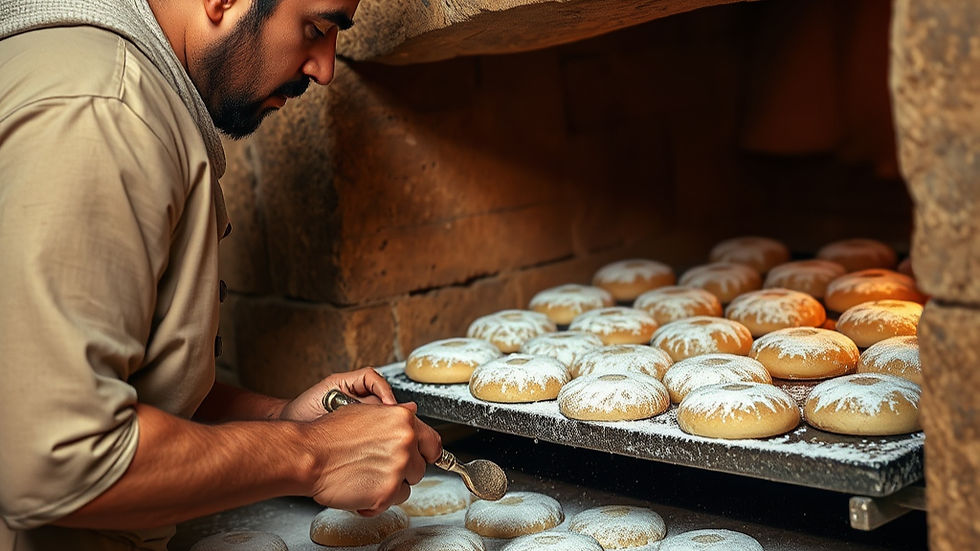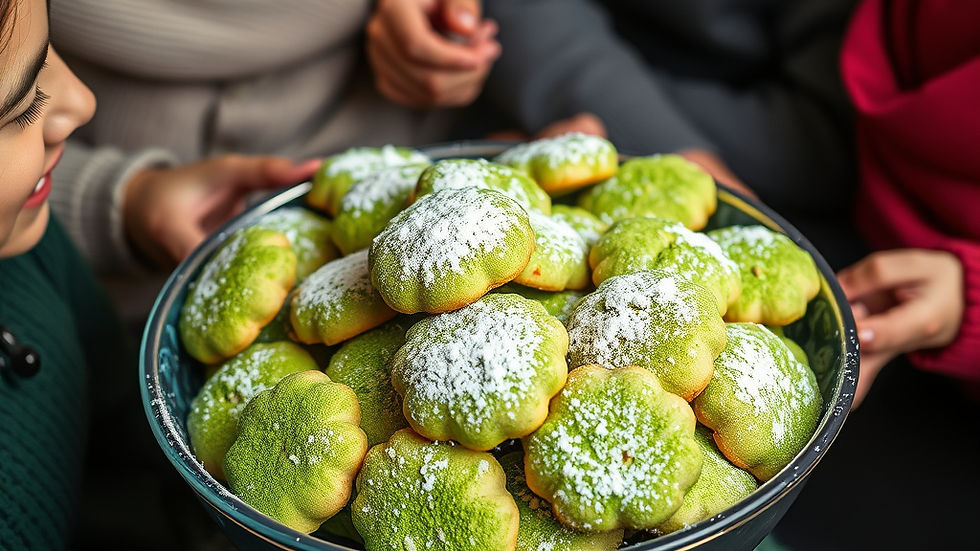Exploring the Sweet Origins of Egyptian Kahk Cookies: History, Culture, and a Homemade Recipe
- thesweetlifecookie
- Jul 27
- 4 min read
Updated: Aug 6
Kahk cookies are more than just a sweet treat in Egypt; they symbolize a deep cultural heritage. These mouthwatering cookies have a history that stretches back to ancient times, and they play a significant role in festive celebrations, especially during Eid. In this article, we explore the fascinating origins of Kahk, its cultural significance, and a simple recipe to make these delightful cookies at home.
The Sweet Legacy of Kahk Cookies
Kahk cookies can trace their roots to ancient Egyptian civilization. Historical evidence suggests that similar baked goods were offered to gods during religious ceremonies. The earliest versions of these cookies were crafted from basic ingredients like flour and honey, showcasing the simplicity of ancient baking.

Baking in ancient Egypt was an intricate practice. Ingredients were valued highly, and methods were often passed down through generations. The famous Pharaohs are said to have enjoyed variations of Kahk flavored with nuts and spices, hinting at the prosperity of their reign.
As Egypt transitioned through many dynasties, the recipes for Kahk were influenced by local customs and ingredients, ultimately transforming into the beloved treat we enjoy today.
Cultural Significance of Kahk
Kahk cookies are not just treats; they embody cultural traditions. Typically baked during the Eid al-Fitr festival, which celebrates the end of Ramadan, these cookies bring families together. The act of sharing Kahk symbolizes love, unity, and communal joy.
Moreover, Kahk figures prominently in other special occasions, such as weddings and birthdays. Often, they are beautifully wrapped and presented as gifts, making them a popular choice for dessert.
The cookies also represent Egyptian identity, as each family usually has its unique recipe, infused with personal stories and traditions. For example, one family might use hazelnuts, while another adds dates or even chocolate, showcasing a variety of tastes and memories.

Fun Facts About Kahk Cookies
Kahk Varieties: Kahk comes in different forms, including those stuffed with nuts, dates, or chocolate, allowing for a range of flavors. In fact, about 40% of people prefer nut-filled Kahk, while others may seek out unique fillings.
Unleavened Treat: Unlike many cookies, Kahk does not use yeast. This gives them a denser, crumbly texture that sets them apart. A traditional chocolate chip cookie could contain 5% yeast, while Kahk's absence leads to its unique consistency.
Festive Shapes: Kahk is often shaped into diverse designs using wooden molds. These molds can display images of nature, animals, or celestial motifs, adding an artistic touch to each cookie. This craftsmanship highlights the cultural significance embedded in each baked piece.
The Secret Ingredient: A mix of spices gives Kahk its signature flavor. Common spices such as cinnamon, nutmeg, and cardamom elevate the taste profile.
Modern Adaptations: Today, many online bakeries offer gourmet Kahk, making it easy for those far from Egypt to enjoy this traditional delight. Statistics show a 30% increase in gourmet cookie purchases in recent years, reflecting a growing appreciation for quality ingredients and traditional recipes.
Baking Kahk Cookies at Home
Ready to experience the joy of baking Kahk in your kitchen? Here is an easy and authentic recipe for you to try!
Ingredients
2 cups all-purpose flour
1 cup unsalted butter, softened
1/2 cup sugar
1/2 teaspoon ground cinnamon
1 cup finely chopped nuts (almonds or walnuts are popular)
1 teaspoon vanilla extract
Powdered sugar for dusting
Pinch of salt
Instructions
Preheat the Oven: Set your oven to 350°F (175°C) to ensure it's ready for your cookies.
Mix Ingredients: In a large bowl, cream the softened butter and sugar until light and fluffy. Stir in the vanilla extract.
Combine Dry Ingredients: In another bowl, whisk together the flour, ground cinnamon, and a pinch of salt. Gradually blend this mixture into the wet ingredients until a dough forms.
Add Nuts: Fold in the chopped nuts, ensuring they are evenly distributed throughout the dough.
Shape the Cookies: Take small portions of dough and roll them into balls. Place them on a baking sheet lined with parchment paper. Optionally, use cookie molds for intricate designs.
Bake: Bake for about 15-20 minutes or until the cookies are lightly golden.
Cool and Garnish: Allow the cookies to cool before dusting them generously with powdered sugar.
Pairing Suggestions
Kahk cookies are delightful with a hot cup of tea or coffee, balancing their sweetness. They can also be paired with milk or Karkadeh, a traditional Egyptian hibiscus drink, enhancing the overall experience.

The Enduring Legacy of Kahk
Today, Kahk cookies remain a cherished part of Egyptian culture. They evoke memories of family gatherings and community celebrations. Whether in their traditional form or as modern gourmet treats, Kahk continues to delight.
As baking trends evolve, the essence of Kahk lives on, embodying tales of tradition, love, and cultural pride through its sweet flavors.
When you bake your own Kahk at home, you are not just creating a tasty treat; you are connecting to an ancient legacy. So gather your ingredients and embark on your sweet journey into Egypt's rich culinary history.
Final Thoughts
Kahk cookies offer a tasty glimpse into Egypt’s vibrant culture and history. Their evolution from ancient civilization to modern-day celebrations highlights the delicacies that bring families together. Armed with this knowledge and a recipe, you can create a little piece of history in your kitchen.
Enjoy the process and the sweet life that comes with it! Happy baking!






Comments